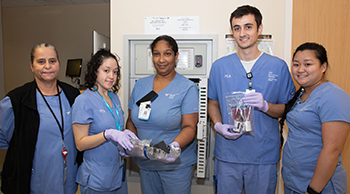Quality and safety: A team sport

Patient care associates involved in MICU Blood Culture Collection Teams include (l-r): Carmen Santiago, Emelie Agrinsoni, Raejeanne Guevara, Sean Deegan and Jennifer Ung.
Some of Yale New Haven Hospital’s most noteworthy quality and safety improvements are occurring in unexpected places – where incredibly complex care takes place and patients are often most vulnerable.
The Medical Intensive Care Unit (NP 9 and 10) has some of the highest rates of central-line use, but some of the lowest numbers of central line-associated bloodstream infections (CLABSIs).
CLABSIs occur when bacteria or fungi contaminate catheters that are inserted in patients’ veins to deliver medications. They can be tricky to diagnose, because blood samples taken for testing can become contaminated during the collection process. They might also result in longer hospital stays.
Jen Barna, RN, MICU, clinical outcomes leader, conceived of and developed an innovative idea: Blood Culture Collection Teams that follow strict procedures and cross-check one another during draws.
Since the teams were implemented on the MICU, CLABSIs have plummeted from 21 in 2015 to three in 2018. Barna was recognized nationally for her work, and the hospital’s CLABSI Committee deemed the Collection Team a best practice that has since been rolled out hospital-wide. Like the Neurosciences Intensive Care Unit, NP 9 decreased its catheter-associated urinary tract infections (CAUTIs) – from eight in 2017 to two during 2018.
Among the strategies that have helped the MICU and NICU improve on key safety and quality measures:
- Keeping key safety concerns – CAUTIs, CLABSIs, falls or others – top of mind. “We highlighted CAUTI reduction as a major initiative and developed a culture of awareness around it,” said Heather Duggan, RN, Neurosciences ICU clinical outcomes leader.
- Knowing their patient populations – and individual patients. Neurosciences ICU patients often develop fevers due to their neurologic conditions that aren’t related to infection and don’t require antibiotics.
- Practicing a questioning attitude. To reduce CAUTIs, clinicians frequently question whether patients need Foley catheters and, if so, how soon they can safely be removed.
- Embracing change – however challenging it might be. “The Blood Culture Collection Team was a major shift in procedure that took some getting used to, but the results were dramatic,” Barna said.
One of the most important factors in improving quality and safety is buy-in from physicians and staff.
“It’s not just nurses who change the safety culture – it’s physicians, advanced practice providers, patient care associates, infection preventionists and others,” said Kelly Poskus, RN, NICU patient service manager. “It’s everybody on the team.”



